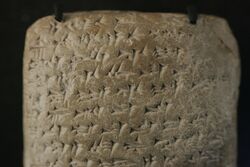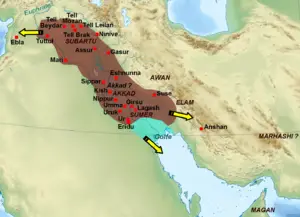Difference between revisions of "How Did Sargon of Akkad Influence Ancient Mesopotamian History"
m (Admin moved page How Did Sargon of Akkad Influence Ancient Mesopotamian History? to How Did Sargon of Akkad Influence Ancient Mesopotamian History) |
|
(No difference)
| |
Latest revision as of 23:09, 22 September 2021
Few rulers in ancient Mesopotamia influenced history more than Sargon I, also known as Sargon of Akkad (ruled ca. 2334-2279 BC). Rising to power from obscurity, from a city that has still not been located by archaeologists, Sargon led his people, the Akkadians, to conquer most of Mesopotamia, instituting many enduring changes in the process. Perhaps the most important, and certainly the most apparent, influence Sargon had on Mesopotamia was the introduction of the Akkadian language, which was still used over 2,000 after the king’s death. Sargon also influenced Mesopotamia in the shorter term by unifying the region under one dynasty and instituting changes to the religion and royal ideology followed by subsequent dynasties.
The Origins of Sargon and the Akkadians
Sargon’s origins are murky, and the ancient written sources that chronicle his early life are more legends than historical texts. In the late third millennium BC, when Sargon came to power, Mesopotamia was a collection of several city-states ruled by numerous ethnicities that often spoke different languages. The Sumerians were the first dominant ethnic group in Mesopotamia. Although they brought all the hallmarks of civilization to the region, such as writing, they could only place the southern part of Mesopotamia under their rule.
After the Sumerians, Mesopotamia went back to competing city-states, how Sargon and the Akkadians came to power. Today, scholars are still unsure precisely where Akkad's ancient city was located, sometimes spelled “Agade.” Still, it is believed to have been in the northern part of southern Mesopotamia. Sargon and his people spoke a Semitic language that is today known as Akkadian, and the dynasty that Sargon initiated is known as the Akkadian Dynasty. [1]
The only primary sources that shed any light on Sargon’s origins were written after his death and are usually laudatory legends. One legend states that Sargon was born along the Euphrates River to a high-priestess mother and a father he never knew. [2] Although the text offers little about Sargon’s family, the mention of the Euphrates River may indicate a general location of Akkad. Some modern scholars believe that Akkad was located in the vicinity of Kish's city, due to Sargon often referring to himself as the “Son of Kish.” In contrast, others think that it was at the confluence of the Tigris and Diyala rivers. [3]
How Sargon came to rule over most of Mesopotamia was quite simple – he did it through warfare and eliminated his most potent rival. Sometimes, while Sargon was the King of Kish and Akkad, Lugalzagesi was the king of Uruk's powerful city. Uruk had a long and illustrious history dating back to the Sumerians and the late fourth millennium BC and was still quite powerful in Sargon’s time. Lugalzagesi unified most of Mesopotamia under his rule, so when Sargon overthrew him, he had a ready-made empire in his hands. [4] A cuneiform historical text dated to the Akkadian Dynasty's end describes how Sargon sieged Uruk and then took Lugalzagesi captive.
“Sargon, king of Agade, overseer of Ishtar, king of Kish, anointed priest of Anu, king of the country, great ensi of Enlil; he defeated Uruk and tore down its wall; in the battle with the inhabitants of Uruk, he was victorious. Lugalzaggisi, king of Uruk, he captured in (this) battle, brought him in a (dog) collar to Enlil's gate. Sargon, king of Agade, was victorious in the battle with Ur's inhabitants, the(ir) town he defeated and tore down its wall.” [5] Once Sargon had eliminated Uruk’s resistance, he was free to embark on his program to change Mesopotamia.
The Akkadian Language
Sargon of Akkad’s greatest influence on ancient Mesopotamia was his introduction of the Akkadian language. Before Sargon came to power, the primary language spoken and written in Mesopotamia was Sumerian, a language isolate, meaning that it was a language not related to any other. Sumerian was written in the cuneiform script, comprised of wedge-shaped characters that were usually written on clay tablets and used for nearly 1,000 years before Sargon’s arrival. After Sargon took power, he and his followers kept using the cuneiform script, but with their native Akkadian language.
The Akkadian language was the first Semitic language to be written. Although it was Sargon and his dynasty's primary language, the Akkadians continued to use Sumerian in many administrative, legal, and literary texts. [6] The Akkadian royal inscriptions, though, which is how modern historians know so much about Mesopotamian chronology, were always written in Akkadian but sometimes accompanied with Sumerian translations. [7] It would not be until after Sargon and his Akkadian Dynasty were gone that his linguistic influence was felt across the region.
Every important dynasty in Mesopotamia after the Akkadians and some dynasties outside of Mesopotamia used the Akkadian language in their writings. The First Dynasty of Babylon (ca. 1894-1595 BC), of which the famous King Hammurabi (ruled ca. 1792-1750) was a member, used Akkadian for most of their important written texts and even the Hittites (ca. 1650-1207 BC), who built their empire to the north of Mesopotamia in Anatolia, wrote many Hittite-Akkadian bilingual texts. [8] The later Kassite (ca. 1374-1155 BC), Neo-Assyrian (934-609 BC), and Neo-Babylonian (625-539) dynasties all used Akkadian for their religious and historical texts. Many of the documents that describe Sargon’s legendary origins have been dated to the Neo-Assyrian and Neo-Babylonian Empires. [9] Finally, even monumental inscriptions during the Achaemenid Empire (550-330 BC) usually used Akkadian along with Old Persian, Elamite, and sometimes Egyptian. The Akkadian language had its most significant influence, though, during the Late Bronze Age.

Akkadian was the primary written language used in Mesopotamia long after Sargon’s death. Still, it also became the lingua franca of the greater Near East during the Late Bronze Age. By about 1500 BC, the most powerful kingdoms of the Near East – Egypt, Kassite Babylon, Mitanni, Assyria, and Hatti – all developed extensive trade networks and diplomatic ties. All of the major kingdoms and the minor kingdoms that served as buffer states wrote to each other in Akkadian to communicate. A cache of over 300 Akkadian diplomatic tablets was discovered in the Egyptian city of Tell el-Amarna (ancient Akhenaten) in 1887.
The letters reveal the details of this early global system that used Akkadian as the primary language. [10] Along with the Akkadian diplomatic letters discovered in Egypt, scores of Akkadian literature tablets have been discovered outside of Mesopotamia, including the Hittite capital of Hattusa, the Levant cities of Ugarit and Megiddo, and Amarna. Akkadian's use eventually became so widespread that all of the original Mesopotamian myths were translated from Sumerian into Akkadian. [11]
Sargon’s Empire
Sargon’s introduction of the Akkadian language to the greater Mesopotamian population may have been his most enduring influence on the region. Still, his quest to unify Mesopotamia under one king was his most immediate impact. Regions within Mesopotamia had been conquered and ruled over by a single ruler before Sargon. Still, he was the first to conquer most of Mesopotamia and hand the rule over to his successors, thereby creating the first trans-ethnic Mesopotamian dynasty. According to the Akkadian historical texts, Sargon’s empire was built on blood and a vast army for the period.
“Sargon, king of Kish, was victorious in 34 campaigns and dismantled (all) the cities, as far as the shore of the sea. At the wharf of Agade, he made moor ships from Meluhha, ships from Magan, (and) ships from Tilmun. Sargon, the king, prostrated (himself) in prayer before the God Dagan in Tutul (and) he gave (him) the Upper Region (i.e.) Mari, Iarmuti (and) Ibla as far as the Cedar Forest and the Silver Mountain. Enlil did not let anybody oppose Sargon, the king. 5,400 soldiers ate daily in his palace (lit.: presence).” [12]
In the wake of his bold conquests, Sargon initiated new government reforms. He allowed the kings of the numerous city-states to stay in power nominally, but as governors who were expected to pay the Akkadians taxes, as well as a workforce in times of war. Regarding the bureaucracy, Sargon mandated that all accounting methods and weights, and measures be standardized, which helped to better integrate the economies of the many city-states into one imperial system. [13]
Finally, Sargon of Akkad made some changes to Mesopotamian religion and ensured that other established traditions were continued. One of the most important religious moves he made, which was probably influenced by political considerations, was installing his daughter, Enheduanna, as the bride of the moon-god Nanna. As the bride, Enheduanna performed important religious rituals for the Nanna cult at the cult center in Ur. Although the office may have existed previously, its importance grew with Sargon’s patronage. [14] Sargon was a pious believer in the Mesopotamian pantheon, but he was also a shrewd leader who no doubt wanted to keep a close eye on the city of Uruk, which was the home of his one-time rival.
Sargon also carried on many of Mesopotamian kingship traditions, namely concerning his royal epithets and titulary. For example, he referred to himself as the “King of Kish” despite Akkad being his home city. He was also known as the “King of the Four Quarters,” which was an epithet that all later Mesopotamian kings used later in one form or another. [15]
Conclusion
When all of the many great kings of ancient Mesopotamian history are considered, few can compare their overall influence with Sargon of Akkad. Sargon took a previously unknown city-state to the pinnacle of power, creating a dynasty that affected Mesopotamia for centuries. Sargon did this through sheer force, unifying most Mesopotamia through war and then initiating reforms to the government and religion. But the most enduring influence Sargon had on Mesopotamia was the introduction of the Akkadian language, which became the primary written language of ancient Mesopotamia and was for a time the lingua franca of the ancient Near East’s elite class. Truly, few individuals in ancient Mesopotamia were as influential as Sargon of Akkad.
Related DailyHistory.org Articles
- How Did Antiochus III Influence the Hellenistic World?
- How Did Nebuchadnezzar Impact Ancient Near Eastern History?
- How Was Science Practiced in Ancient Babylon?
- Why Did Babylon Collapse in the Late Bronze Age?
- What Was the Importance of Ziggurats in Ancient Mesopotamia?
- How Were the Assyrians able to Conquer the Ancient Near East
References
- ↑ Kuhrt, Amélie. The Ancient Near East: c. 3000-330 BC. (London: Routledge, 2010), p. 44
- ↑ Pritchard, James B, ed. Ancient Near Eastern Texts Relating to the Old Testament. 3rd ed. (Princeton, New Jersey: Princeton University Press, 1992), p. 119
- ↑ Kuhrt, p. 44
- ↑ Kuhrt, pgs. 45-46
- ↑ Pritchard, p. 267
- ↑ Kuhrt, p. 46
- ↑ Mieroop, Marc van de. A History of the Ancient Near East: ca. 3000-323 BC. 2nd ed. (London: Blackwell, 2007), pgs. 65-66
- ↑ Mieroop, p. 122
- ↑ Pritchard, p. 119
- ↑ Moran, William L. The Amarna Letters. (Baltimore: John Hopkins University Press, 1992), p. xiii
- ↑ Meiroop, p. 116
- ↑ Pritchard, p. 268
- ↑ Mieroop, pgs. 64-65
- ↑ Kuhrt, p. 50
- ↑ Frankfort, Henri. Kingship and the Gods: A Study of Ancient Near Eastern Religion As the Integration of Society and Nature. (Chicago: University of Chicago Press, 1978), pgs. 226-8
Updated December 4, 2020


